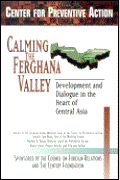Of all the regions of the former Soviet Union, Central Asia is potentially one of the most explosive and certainly one of the least understood. It is also growing rapidly in importance to U.S. national security, commercial, and foreign policy interests: it has vast oil, gas, gold, and other resources; it has become a source and transit route for narcotics and possible nuclear and other materials; and it is affected by the fierce conflicts in Tajikistan and Afghanistan. Vast in size (larger than Eastern and Western Europe combined), and with a rapidly growing population of over 50 million people, it is marked by the persistence of relatively corrupt and authoritarian governments.
This report assesses the potential for conflict in Central Asia through the prism of one of its most volatile areas, the Ferghana Valley. Spanning parts of Tajikistan, Uzbekistan, and Kyrgyzstan, the Ferghana Valley is home to 20 percent of Central Asia’s entire population. The region has recently experienced increasing religious and ethnic tensions–the further danger being that instability in the valley could spread more widely throughout Central Asia. The Ferghana Valley project of the Council on Foreign Relations’ Center for Preventive Action (CPA) has produced this report as the fourth volume in its series of Preventive Action Reports.
Sponsored by The Council on Foreign Relations and The Century Foundation.

